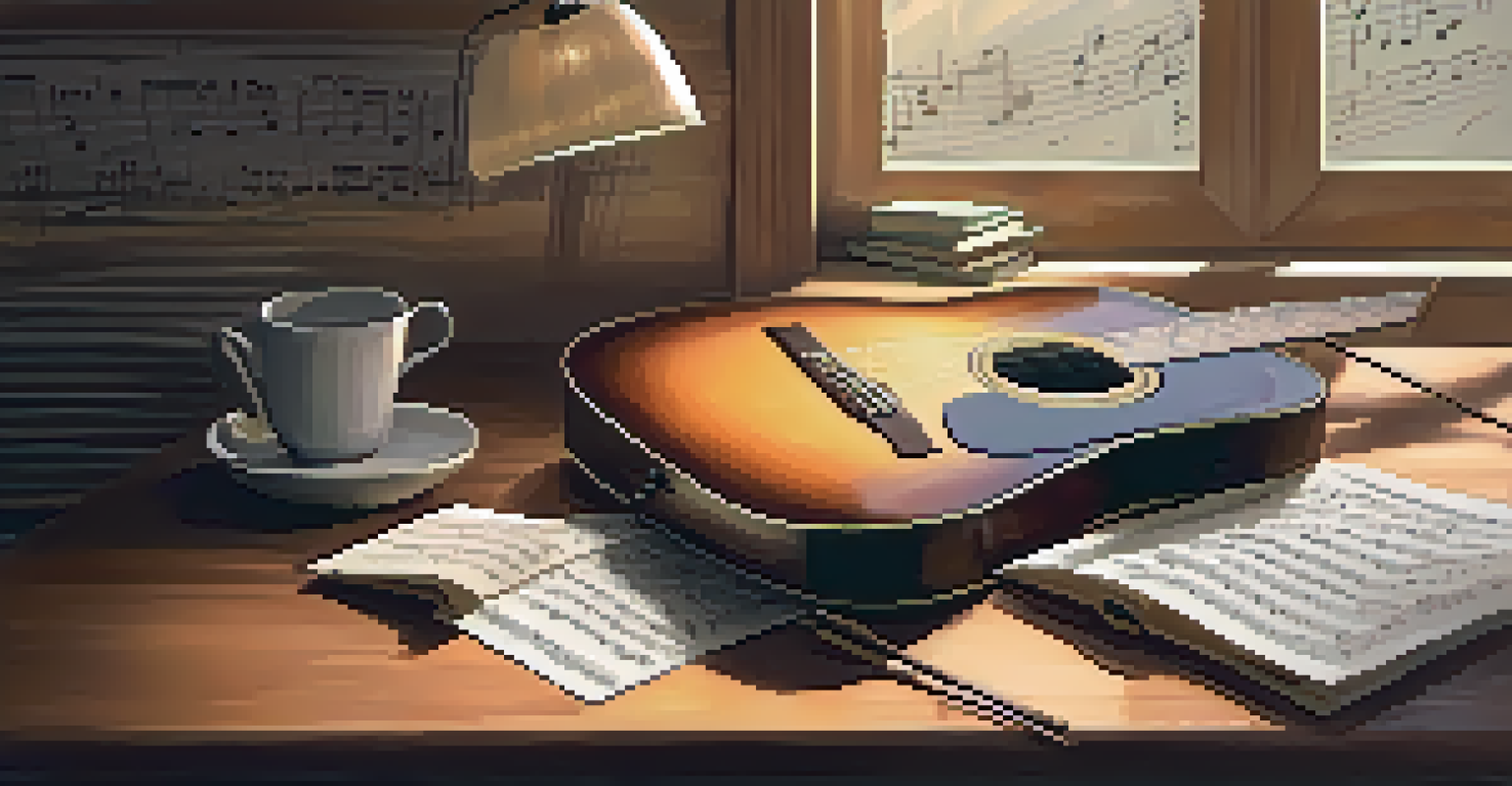Exploring Basic Guitar Chords for Composition Success

Understanding the Importance of Guitar Chords in Songwriting
Guitar chords form the backbone of most songs, providing harmony and structure. Whether you’re strumming in a coffee shop or jamming with friends, knowing your chords can elevate your musical experience. They help you express emotions and tell stories through music, making them essential for any aspiring songwriter.
Music is the shorthand of emotion.
Think of guitar chords like the foundation of a house. Without a solid base, everything else can crumble. Similarly, your melodies and lyrics will shine brighter when supported by well-chosen chords, allowing your songs to resonate with listeners.
In essence, mastering basic guitar chords opens up a world of creativity. You’ll find that you can easily experiment with different sounds and styles, ultimately leading to more successful compositions.
Getting Started: Essential Basic Guitar Chords
Before diving into composition, it’s crucial to familiarize yourself with basic chords. Start with the major chords like C, G, D, and A, as they create a bright, uplifting sound. Minor chords such as Am and Em add depth and emotion, making them equally important to your toolkit.

These chords form the foundation of countless popular songs, so practicing them can also help you learn your favorite tracks. The more you practice, the more intuitive these chords will become, allowing you to focus on songwriting rather than finger placement.
Chords: The Foundation of Songs
Guitar chords provide the essential harmony and structure that elevate songwriting and musical expression.
To make learning enjoyable, try playing along with simple songs that utilize these chords. This not only reinforces your skills but also sparks inspiration for your own compositions.
Chord Progressions: The Heart of Your Composition
Once you’ve grasped the basic chords, it’s time to explore chord progressions. A chord progression is a sequence of chords played in a specific order, and it’s the framework for your song. Popular progressions like I-IV-V or ii-V-I can create familiar yet powerful musical landscapes.
The best music is essentially there to provide you something to face the world with.
Think of chord progressions as a roadmap for your song. They guide the listener through different emotional landscapes, helping to build tension and resolve it as the song unfolds. Experimenting with various progressions can lead to unique and memorable compositions.
Don’t hesitate to mix and match different progressions to find what resonates with you. Sometimes, a simple tweak can transform a mundane progression into something magical!
Using Strumming Patterns to Enhance Your Chords
Strumming patterns can add rhythm and flavor to your basic chords, making your songs more engaging. Experimenting with different strumming techniques can completely change the feel of a song. For instance, a steady down-up strum creates a laid-back vibe, while a more complex pattern can bring energy and excitement.
Think of strumming as the seasoning in your favorite dish. Just as a pinch of salt can elevate flavors, the right strumming pattern can bring your chords to life. The key is to practice and find a pattern that complements your song’s mood.
Master Basic Chords for Success
Familiarizing yourself with essential major and minor chords allows for easier songwriting and creativity.
You can also explore fingerpicking techniques for a softer, more intricate sound. This skill adds a layer of complexity and can be especially effective in ballads and intros.
Lyrics and Melody: Collaborating with Your Chords
Once you have your chords and progressions in place, it’s time to weave in lyrics and melodies. The chords provide a harmonic foundation, while lyrics express your message and emotions. Think about what story you want to tell and find ways to match your words to the mood of the chords.
It can be helpful to hum or sing over your chord progressions to find a melody that fits. Don’t be afraid to play around with different rhythms and pitches until something clicks. This exploration is where the magic of songwriting happens.
Remember, your chords and melodies should work together like a well-rehearsed duo. The more you practice this interplay, the more seamless your compositions will become.
Experimenting with Chord Variations and Extensions
While basic chords are fantastic, exploring variations and extensions can add richness to your compositions. Chord variations, like adding a seventh or ninth, can create a more sophisticated sound. This experimentation can help you stand out and develop your unique musical style.
Consider how different variations can change the mood of your song. A simple C major chord can shift to a Cmaj7, adding a jazzy feel, while a C7 can introduce a bluesy vibe. These subtle changes can enhance your song’s emotional impact.
Enhance Songs with Progressions
Chord progressions guide the emotional flow of your music, making them a crucial element in composition.
Don’t shy away from trying out unusual chord shapes or voicings. Sometimes, the most unexpected chords can lead to the most beautiful musical discoveries.
Putting It All Together: Creating Your First Composition
Now that you have a solid grasp of basic chords, progressions, strumming patterns, and melodies, it’s time to create your first composition. Start by choosing a chord progression that resonates with you and build from there. Don’t worry about perfection; focus on expressing your thoughts and feelings through your music.
As you write, remember to incorporate the techniques you’ve learned. Experiment with different strumming patterns and chord variations to see how they influence your sound. This process is all about exploration and creativity.

Lastly, share your composition with friends or fellow musicians for feedback. Their insights can provide valuable perspectives, helping you refine your work and grow as a songwriter.